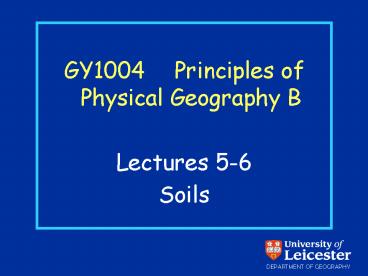GY1004 Principles of Physical Geography B - PowerPoint PPT Presentation
1 / 32
Title:
GY1004 Principles of Physical Geography B
Description:
The finer the texture of the soil, the greater is the effective ... Catena. Zonal soil classification. Zonal soil classification. Zonal. Azonal. Intra zonal ... – PowerPoint PPT presentation
Number of Views:337
Avg rating:3.0/5.0
Title: GY1004 Principles of Physical Geography B
1
- GY1004 Principles of Physical Geography B
- Lectures 5-6
- Soils
DEPARTMENT OF GEOGRAPHY
2
Soil processes and patterns
The soil process-response system Horizonation
processes Soil types, classification and the
global distribution of soils
3
Soil process-response system
4
Horizonation processes
- Lessivation
- Leaching
- Translocation
- Mixing
5
(No Transcript)
6
Lessivation
The finer the texture of the soil, the greater is
the effective surface area exposed by its
particles
7
(No Transcript)
8
Leaching
Rainwater
Leaf litter
L A Eb Bt C
Organic acids H
Leaching and loss of clay particles, acc. of
organic matter
Clay particles Ca2 Mg2 Na K
Accumulation of clay, iron and bases
Some loss (Ca2 Mg2 Na K)
Some loss to drainage water
9
Re-precipitation of CaCO3
10
Calcification
11
Podsolisation
O A Ea B C
12
Pedalfers and Pedocals
PedALFErs Aluminium (Al) and iron (Fe) rich
PedoCAls Calcium (Ca) rich
13
Upward translocationSalinisation
14
Gleying
15
Bivalent (Fe2) Ferrous iron oxide FeO (Reduced
form)
Trivalent (Fe3) Ferric iron oxide Fe2O3
(Oxidised form)
Laterite
Gley soil
16
Soil process-response system
17
Factors controlling soil development
- Climate
- Parent material
- Vegetation/organic matter
- Topography/relief
- Time
18
The influence of climate
19
Variation in the character of the weathered
mantle in relation to climate (Strakov, 1967)
20
The influence of topography
21
Catena
22
Zonal soil classification
23
Zonal soil classification
- Zonal
- Azonal
- Intra zonal
24
Comprehensive Soil Classification System CSCS
Mollisols Aridisols aridus
solum Inceptisols inceptum solum
- Order 12
- Suborder 63
- Great group 250
- Sub group 1,400
- Family 8,000
- Series 19,000
- (USA only)
25
The twelve soil orders of the CSCS
- Entisols
- Inceptisols
- Andisols
- Gelisols
- Histosols
- Oxisols
- Ultisols
- Vertisols
- Alfisols
- Spodsols
- Mollisols
- Aridisols
26
(No Transcript)
27
(No Transcript)
28
(No Transcript)
29
(No Transcript)
30
Summary
- The internal characteristics of a soil depend on
the operation of horizonation processes
(leaching, gleying, translocation). - Fundamental differences in soils are found over
the Earths surface as a result of differences in
soil forming processes.
31
Summary
- The intensity of these processes is controlled
by five major factors - climate, parent, material, vegetation, relief
and time. These processes operate at a range of
scales and control both the global and local
distribution of soil types.
32
Summary
- It is possible to define environmental domains
for different soils and develop zonal models of
soil development and classification on the basis
of formative processes. - The US Comprehensive Soil Classification System,
however, classifies soils on the basis of their
physical characteristics, rather than formative
processes. It is a six-level hierarchical
classification based on 12 broad soil orders.































